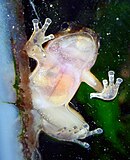Aromobatidae
| Aromobatidae | |
|---|---|

| |
| Allobates femoralis | |
| Scientific classification | |
| Domain: | Eukaryota |
| Kingdom: | Animalia |
| Phylum: | Chordata |
| Class: | Amphibia |
| Order: | Anura |
| Superfamily: | Dendrobatoidea |
| Family: | Aromobatidae Grant, Frost, Caldwell, Gagliardo, Haddad, Kok, Means, Noonan, Schargel & Wheeler, 2006[1] |
| Subfamilies and genera | |
| |
The Aromobatidae are a family of frogs native to Central and South America.[2][3][4] They are sometimes referred to as cryptic forest frogs. They are the sister taxon of the Dendrobatidae, the poison dart frogs, but are not toxic as most dendrobatids are.[1][4]
Taxonomy
The Aromobatidae were separated from the Dendrobatidae only in 2006, and some sources continue to treat these frogs as part of the Dendrobatidae.[5] However, their position as the sister taxon is well supported, and the question is primarily about whether they should be ranked as a family or a subfamily.[2][3]
The validity of subfamilies within the Aromobatidae is also unsettled. Some evidence points to paraphyly of at least the Anomaloglossinae subfamily, and genus Allobates, largely because of the uncertain placement of Allobates olfersioides.[2][3]
Reproduction
Many aromobatids deposit small clutches of eggs in terrestrial nests. After hatching, one of the parents transports the tadpoles to a small water body, where they complete their development to metamorphosis.[4]
Subfamilies and species
By 2014, 117 species in three subfamilies and five genera had been described:[2]
- Allobatinae Grant, Frost, Caldwell, Gagliardo, Haddad, Kok, Means, Noonan, Schargel, and Wheeler, 2006 (48 spp.)
- Allobates Zimmermann and Zimmermann, 1988 (48 sp.)
- Anomaloglossinae Grant, Frost, Caldwell, Gagliardo, Haddad, Kok, Means, Noonan, Schargel, and Wheeler, 2006 (31 spp.)
- Anomaloglossus Grant, Frost, Caldwell, Gagliardo, Haddad, Kok, Means, Noonan, Schargel, and Wheeler, 2006 (29 spp.)
- Rheobates Grant, Frost, Caldwell, Gagliardo, Haddad, Kok, Means, Noonan, Schargel, and Wheeler, 2006 (twp spp.)
- Aromobatinae Grant, Frost, Caldwell, Gagliardo, Haddad, Kok, Means, Noonan, Schargel, and Wheeler, 2006 (37 spp.)
- Aromobates Myers, Paolillo-O., and Daly, 1991 (18 spp.)
- Mannophryne La Marca, 1992 (19 spp.)
In addition, "Prostherapis" dunni Rivero, 1961 is placed in this family, but its more precise placement is unknown; it might be an Aromobates.[6]
References
- ^ a b Grant, T.; Frost, D. R.; Caldwell, J. P.; Gagliardo, R.; Haddad, C. F. B.; Kok, P. J. R.; Means, D. B.; Noonan, B. P.; Schargel, W. E.; Wheeler, W. C. (2006). "Phylogenetic systematics of dart-poison frogs and their relatives (Amphibia: Athesphatanura: Dendrobatidae)" (PDF). Bulletin of the American Museum of Natural History. 299. American Museum of Natural History: 1–262. doi:10.1206/0003-0090(2006)299[1:PSODFA]2.0.CO;2.
{{cite journal}}: Unknown parameter|last-author-amp=ignored (|name-list-style=suggested) (help) - ^ a b c d Frost, Darrel R. (2014). "Aromobatidae Grant, Frost, Caldwell, Gagliardo, Haddad, Kok, Means, Noonan, Schargel, and Wheeler, 2006". Amphibian Species of the World: an Online Reference. Version 6.0. American Museum of Natural History. Retrieved 30 August 2014.
- ^ a b c Blackburn, D.C.; Wake, D.B. (2011). "Class Amphibia Gray, 1825. In: Zhang, Z.-Q. (Ed.) Animal biodiversity: An outline of higher-level classification and survey of taxonomic richness" (PDF). Zootaxa. 3148: 39–55.
- ^ a b c Vitt, Laurie J.; Caldwell, Janalee P. (2014). Herpetology: An Introductory Biology of Amphibians and Reptiles (4th ed.). Academic Press. pp. 486–488.
- ^ "Dendrobatidae". AmphibiaWeb: Information on amphibian biology and conservation. [web application]. Berkeley, California: AmphibiaWeb. 2014. Retrieved 30 August 2014.
- ^ Frost, Darrel R. (2014). ""Prostherapis" dunni Rivero, 1961". Amphibian Species of the World: an Online Reference. Version 6.0. American Museum of Natural History. Retrieved 30 August 2014.




